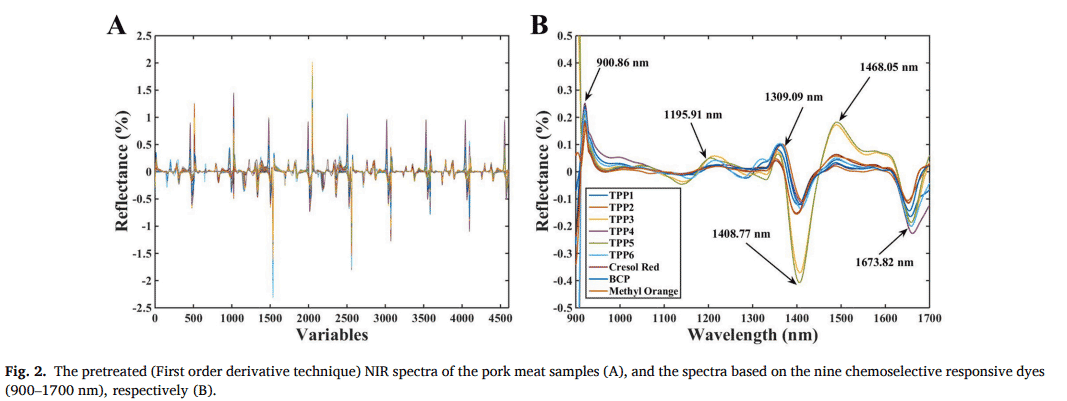Wenya Wei, Huanhuan Li, Suleiman A. Haruna, Jizhong Wu, Quansheng Chen
Abstract
The quality of pork meat is vital since it is one of the most essential sources of proteins and other nutrients. Near-infrared spectroscopy via colorimetric sensor array (NIRS-CSA) technology as a novel approach combined with multivariate calibrations was proposed to quantitatively evaluate total volatile basic nitrogen (TVB-N) as an indicator of freshness in pork. Using nine chemoselective dyes, the CSA was initially fabricated. The synergy interval-partial least squares (Si-PLS) was applied to select optimum variable intervals. Thereafter, different variable selection algorithms were executed, evaluated and compared. By utilizing 61 variables (7.73% of the Si-PLS variables), the synergy interval- competitive adaptive reweighted sampling-partial least squares (Si-CARS-PLS) model yielded preeminent performance with Rp = 0.9850, RMSEP= 0.7148, and RPD = 6.00. Therefore, this study discovered that combining NIRS-CSA with Si-CARS-PLS as efficient variable selection algorithm could be employed as a fast and cheap strategy for assessing the freshness of pork meat during storage.
Data acquisition by NIRS-CSA system
The NIRS data from each color sensitive unit, which are the sites in the silica gel after interacting with the gas emitted by pork, was collected and recorded in this study (Fig. 1B). The data were collected with a portable NIRS analyzer (DWARF-Star NIR spectrometer, StellarNet, Inc., Oldsmar, USA) with a wavelength range of 900–1700 nm. The spectrometer was equipped with an indium gallium arsenide (InGaAs) detector and a tungsten halogen lamp that produced 20 W dc (SL1-CAL, StellarNet, Inc., Oldsmar, Florida, USA). The spectra were acquired in a reflectance mode. The integration time was set to 70 ms, with 10 and 5 being set for smoothness and average scanning time, respectively. Furthermore, the room temperature was kept at 25 ◦C to reduce the effects of ambient variables on the portable spectrum system. For further multivariate processing, the triple readings from the same sample were averaged. During spectral acquisition, the fiber’s optical spot center was aligned with the center of each printing point. In addition, to overcome the issue of inaccuracy, the distance between the silica gel plate and the optical fiber must be perfectly consistent, and the average spectra of the colorimetric unit must be calculated using a multiple collection approach.
Conclusion
In summary, a platform for detecting TVB-N as a specific indicator of freshness in pork meat has been developed using a CSA and NIRS combined with multivariate calibrations. Utilizing the nine chemo-selective dyes, a simple sensor was fabricated and VOCs were successfully emitted from the pork meat samples during the storage period. NIRS was then used to acquire spectra of CSA based on the interaction of VOCs released by the meat sample, followed by application of chemometrics. The Si-CARS-PLS model performed better, as indicated by high Rp values as well as low RMSEP values, which is especially evident with an RPD value of 6.00. Consequently, the NIRS-CSA system paired with the Si-CARS-PLS model gave excellent results as a unique approach for predicting TVB-N in pork during storage. Finally, due to the nutritional benefits of pork meat, the developed method could be applied to assess the freshness of pork meat as a component of the significant problems aggravating the meat industry and consumers.






